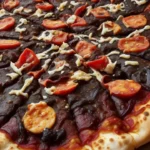Pizza and pie crust are two beloved staples in the culinary world, each with its own history and charm. What’s the result when you merge the two? Can You Make Pizza with Pie Crust? A Pleasant Wind on a Classic Dish The answer is yes, and the result is a delightful fusion that offers a unique take on traditional pizza. In this article, we’ll explore the history of both pizza and pie crust, delve into how they can be combined to create a delicious dish, and offer tips and recipes for making your own pizza with pie crust at home.
The Origins of Pizza and Pie Crust
Pizza: The history of pizza dates back to ancient times, with roots in various flatbread dishes from different cultures. Naples, Italy, is the birthplace of the modern pizza, which emerged in the 18th century with its characteristic tomato sauce, cheese, and toppings. This dish quickly gained popularity, particularly among the working class, as it was affordable, easy to eat, and delicious. Pizza made its way to the United States with Italian immigrants in the late 19th and early 20th centuries, where it became a staple of American cuisine. Today, pizza is enjoyed worldwide in countless variations, from classic Margherita to deep-dish Chicago style.
Pie Crust: Pie crust, on the other hand, has an even older history, with its origins tracing back to ancient Egypt, Greece, and Rome. Early pies were often savory rather than sweet, encased in a thick, inedible crust called a “coffin” that was used to preserve the filling. Over time, pie crust evolved into the flaky, buttery pastry we know today, used in both savory and sweet dishes. The development of modern pie crusts can be attributed to European cuisine, particularly in England and France, where pies became a popular dish during the Middle Ages.
Why Use Pie Crust for Pizza?
Using pie crust as the base for pizza offers a different texture and flavor compared to traditional pizza dough. Pie crust is typically flaky, tender, and rich due to the high fat content from butter or shortening. This contrasts with the chewy, airy texture of classic pizza dough, which is made with yeast and often has a more bread-like quality.
There are several reasons you might consider using pie crust for pizza.
- Convenience: Pie crust, especially pre-made or store-bought versions, can save time and effort in the kitchen. If you have pie crust on hand, it’s an easy way to whip up a quick and tasty pizza.
- Texture: The flaky, buttery texture of pie crust adds a unique twist to pizza, making it feel more like a special treat or gourmet dish. The contrast between the crisp crust and the gooey cheese and toppings can be very satisfying.
- Versatility: Pie crust pizza can be both savory and sweet, opening up a world of creative possibilities. From traditional tomato sauce and mozzarella to dessert-style pizzas with fruit and cream cheese, the options are endless.
- Portion Control: Using pie crust can be a great way to create individual-sized pizzas or tartlets, perfect for parties, appetizers, or a quick meal.
How to Make Pizza with Pie Crust
Making pizza with pie crust is simple and fun, whether you’re using homemade or store-bought crust. Below is a step-by-step guide to creating a delicious pie crust pizza, along with some tips for customizing it to your taste.

Ingredients
Instructions.
- Preheat oven to 400°F (200°C). If using a store-bought pie crust, allow it to come to room temperature for easier handling.
- Unroll the pie crust on a lightly floured surface or directly onto a parchment-lined baking sheet. If you prefer a thicker crust, you can use a double layer of pie crust.
- If desired, brush the edges of the crust with olive oil for a golden finish.
- To prevent the crust from becoming soggy once the toppings are added, par-bake the pie crust for about 8-10 minutes, or until it starts to turn lightly golden. By doing this, you’ll achieve a crust that’s both flaky and crunchy.
- Spread pizza sauce over the crust, leaving a small margin around the edges, after removing it from the oven.
- Sprinkle the shredded mozzarella cheese evenly over the sauce.
- Add your desired toppings, being careful not to overload the crust, as pie crust is more delicate than traditional pizza dough.
- Return the pizza to the oven and bake for an additional 10-12 minutes, or until the cheese is melted and bubbly, and the crust is golden brown.
- Take the pizza out of the oven and give it a few minutes to cool down. Garnish with fresh herbs if desired.
- Slice and serve your pie crust pizza warm. Enjoy the delightful combination of flaky crust, rich toppings, and gooey cheese!
Variations and Creative Ideas
One of the great things about using pie crust for pizza is the opportunity to get creative with your toppings and flavor combinations. Get inspired to try new flavors with these suggestions!
Savory Pie Crust Pizzas.
- White Pizza: Instead of tomato sauce, use a base of ricotta cheese mixed with garlic and herbs. Fiery, creamy, divine: the trio of mozzarella, Parmesan, and red pepper flakes elevates your dish to new heights.
- Pesto and Veggie: Spread a layer of basil pesto over the crust, and top with sliced cherry tomatoes, zucchini, and bell peppers. Add mozzarella and bake until golden and bubbly.
- BBQ Chicken: Use BBQ sauce as the base, then add shredded cooked chicken, red onions, and cheddar cheese. Garnish with cilantro after baking for a zesty twist.
Sweet Pie Crust Pizzas.
- Apple Cinnamon: Use a layer of cream cheese sweetened with a bit of honey or sugar as the base. Top with thinly sliced apples, a sprinkle of cinnamon, and a drizzle of caramel sauce after baking.
- Nutella and Strawberry: Spread Nutella over the par-baked crust and top with sliced strawberries. After baking, dust with powdered sugar or add a dollop of whipped cream for a decadent dessert.
- Berry and Cream Cheese: Spread a mixture of cream cheese and a touch of lemon zest over the crust, and top with mixed berries like blueberries, raspberries, and blackberries. Bake until the crust is golden and the berries are slightly softened.
History of Fusion Dishes in Cuisine
The concept of combining elements from different culinary traditions to create new dishes is not new. Fusion cuisine has been a part of the culinary world for centuries, driven by trade, exploration, and cultural exchange. Pie crust pizza is a perfect example of this fusion, blending the flaky texture of a classic pie with the savory toppings of a traditional pizza.
Throughout history, chefs have experimented with blending flavors, techniques, and ingredients from various cultures to create innovative dishes. Fusion cuisine became particularly popular in the late 20th century, especially in metropolitan areas where diverse populations brought their culinary traditions together. This led to the creation of iconic dishes like California rolls (a Japanese-American fusion) and Tex-Mex cuisine (a blend of Mexican and American flavors).
Pie crust pizza fits within this tradition of culinary innovation. It takes the familiar comfort of both pizza and pie and combines them into something new and exciting, offering a fresh take on two classic dishes.
Health Considerations
When making pizza with pie crust, it’s important to consider the nutritional differences between pie crust and traditional pizza dough. Pie crust is typically higher in fat and calories due to the butter or shortening used in its preparation. While this gives the crust its rich, flaky texture, it also makes pie crust pizza more indulgent.
To make a healthier version of pie crust pizza, consider the following tips.
- Use Whole Wheat Pie Crust: Opt for a whole wheat or gluten-free pie crust to increase the fiber content and make the pizza more nutritious.
- Limit Toppings: Stick to lighter toppings like vegetables, lean proteins, and a moderate amount of cheese to balance the richness of the crust.
- Serve with a Salad: Pair your pie crust pizza with a fresh salad to add more vegetables to your meal and create a more balanced plate.
Making pizza with pie crust is a fun and delicious way to enjoy two beloved dishes in one. Whether you’re looking for a quick and convenient meal, a creative twist on pizza night, or a new dessert idea, pie crust pizza offers endless possibilities. The flaky, buttery texture of the pie crust provides a unique contrast to the gooey cheese and rich toppings, making each bite a delightful experience.
This fusion of pizza and pie crust reflects the broader trend of culinary innovation, where traditional recipes are reimagined in exciting new ways. So the next time you’re in the mood for pizza, why not try making it with pie crust? It’s a simple, tasty, and satisfying dish that’s sure to impress your guests and bring a new level of creativity to your kitchen.
Whether you’re sticking to savory toppings or venturing into sweet territory with dessert pizzas, pie crust pizza is a versatile dish that can be tailored to suit any occasion. It’s perfect for family dinners, casual gatherings, or even as a fun cooking project with kids. The combination of pizza’s beloved flavors with the rich, flaky texture of pie crust creates a dish that’s both comforting and unique.
In the world of fusion cuisine, pie crust pizza stands out as an inventive and accessible option that brings together the best of two culinary traditions. So the next time you’re feeling adventurous in the kitchen, give pie crust pizza a try—you might just discover a new favorite way to enjoy this timeless dish.





I couldn’t resist commenting. Well written!!